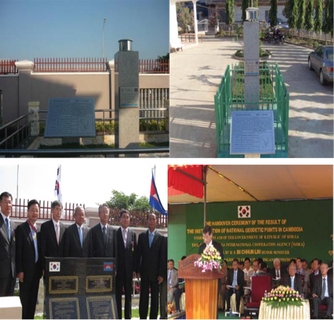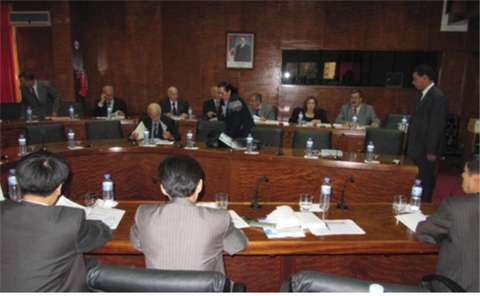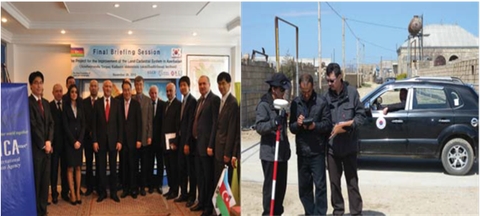capacity building workshops
Aid for governance
1. Overview
KOICA informed project-implementing organizations about the direction of project development. By analyzing four main areas of administrative institutions and developing different project models for each area, organizations can create standard guidelines for project selection.
The administrative institution of a country can be defined to include the entire structure of governance related to the nation’s politics, economy, and the distribution and control of social resources. Because good governance is recognized as essential for sustainable development, the international community has increased aid in this area. For sustainable poverty reduction during development, there must be improvements in governance, including transparency, responsibility, fairness and the level of democratization. The country should also improve its capacity to improve its political, economic and social institutions. Most developing countries lack institutional capacity which is the basis for sustainable development. Therefore, lack of good governance, including efficiency and transparency of public services, and lack of the rule of law hinders efficient economic development in developing countries.
In the governance sector, KOICA implements projects based on Korea’ s development experience. Korea was able to achieve social and economic development and poverty reduction in a short period despite the problems of war, poverty, and lack of natural resources. The unique development experience that Korea acquired in the area of social resources through this process may help developing countries improve governance.
KOICA helps developing countries to improve governance and gain autonomous and sustainable development by supporting the development of government capacity through projects in the administrative institution areas. These include economic development structures, administration and reform and legal systems.
Of the eight MDGs, the area of administrative institution is related to Goal 1, “Eradicate Extreme Hunger and Poverty,” and Goal 8, “Develop a Global Partnership for Development.” The UN Millennium Development Project Team has pointed to governance failure as one of the main reasons why the attainment of MDGs has been delayed despite various efforts of the international community. The US established Millennium Challenge Account (MCA) and has been providing assistance by selecting countries that have well established governance. Internationally, aid in the sectors related to governance is increasing. Its share among ODA provided by OECD/DAC member countries was less than 5% in 2000, 12.4% in 2004, and 9.7% in 2005 (which amounts to approximately USD 10 billion).
Source: Korea International Cooperation Agency. 2011. 20 years of KOICA 1991-2010, Translated by Institute for Development and Human Security, Ewha Womans University. Seoul.
2. Performance
KOICA’s ODA project in the governance sector started in 1992 with the industrial complex project in the Eastern region of Visayas in the Philippines. This kind of project was implemented sparingly in the 1990s and 2000s, but increased rapidly after 2007. Despite the decrease in 2009, it increased slightly in 2010 reaching a total of 54 projects. Because KOICA’s projects in the governance sector are directed at increasing capacity for public service through the improvement of information and communication systems, the future plan is to unify these projects into administration institution.
3. Strategy and Institutional Improvement
First, KOICA has implemented projects that improve the developing country government’s capacity to form economic development strategies, support policies for a market economy and improve the capacity to establish and implement industrial development polices. Strengthening the capacity to pursue economic development is not only an area where Korea has a comparative advantage due to its unique development history, but is also an area that is in great demand by developing countries.
Second, KOICA has helped to invigorate the private sector by supporting small and middle-sized enterprises, building the basis for international trade and promoting exports. It is important to bolster the private sector in addition to strengthening government capacity to pursue economic development in order to achieve efficient poverty reduction through national economic development.
Third, KOICA helps to foster government capacity for administration and reform by growing administrative institutional ability, building corruption-free and efficient administrative institutions, supporting the improvement of administrative services and increasing the efficiency and responsibility of developing country governments. Strengthening the capacity of civil servants and improving administrative management and transparent decision making in the public sector contributes to building good governance. This ultimately plays an important role in efficiently reducing poverty.
Fourth, to achieve the goal of organizing legal systems and stabilizing society, KOICA supports sub goals such as the establishment of an advanced legal system, support for the legal cost of countries in transition, social stability and balanced development. KOICA helps to build legal systems to form the basis for national development and to establish the rule of law. This can then act as a base for problem solving and help stabilize society.
[Figure 3-41] The Governance Sector Strategy
|
Goals |
Strengthen capacity to implement economic development |
Foster administrative ability and reform capacity |
Reorganize legal systems and support social stability |
Invigorate private sector |
|
Targets |
Foster ability to establish economic development plan |
Foster capacity to implement public administration |
Build advanced legal system |
Foster small and middle-sized businesses |
|
Activities |
- Establish mid and long-term economic development plan - Create and manage economic statistics - Establish and run economic research institute |
- Capacity development of civil servants - Share management techniques - Improve structure of public organizations |
- Build and manage advanced legal system - Build system for coexisting with international law and crime prevention |
- Establish policy for fostering small and middle-sized businesses - Establish strategy for promoting investment Build system for registering and managing businesses |
|
Targets |
Support for establishing market economy |
Prevent corruption and build efficient administrative institutions |
Support for the reorganization of legal systems in transition countries |
Build foundation for vitalizing international trade |
|
Activities |
- Build market economy - Build WTO system - Expand competition - Establish national standard system - Establish strategy for privatizing state owned businesses |
- Establish ethics for public offices and prevent corruption - Build fair evaluation system |
- Foster and train legal professionals - Reform legal system |
- Build advanced trade and financial institutions - Foster workforce in the field of international trade - Establish trade promotion organization and support operation |
|
Targets |
Establish industry development policy and implementation capacity |
Improve public administration service |
Support social stability and balanced development |
Promote exports |
|
Activities |
- Establish industry development policy - Establish specific implementation strategy per industry |
- Loosen administrative regulation and strengthen participatory administration - Computerize public administration - Innovate government |
- Strengthen capacity for preventing crime and monitor elections - Strengthen safety services for citizens - Strengthen balanced development and administrative capacity of local areas |
- Establish export promotion strategy - Support free export zone and |
KOICA plans to help developing countries realize efficient governments based on Korea’s advanced technology and infrastructure related to e-government. This includes support programs to build e-government, which can reduce corruption and alleviate the information gap. It also hopes to strengthen national competitiveness and trade capacity by computerizing administration related to tariffs, and by inviting civil servants for training to increase their capacity.
KOICA also hopes to build administrative infrastructure to strengthen the administrative capacity of civil servants. This may reduce the budgetary burden of developing countries in disaster-affected regions and contribute to socio-economic development and industrial foundation.
In addition, KOICA will endeavor to strengthen multilateral cooperation and diversification of economic relations of developing countries. This will increase economic liberalization and allow for more rapid growth after joining the WTO.
In order to increase a developing country’s role and impact in the regional and global economy, KOICA will actively support cooperative projects that can contribute to the development of a capital market economic system. In addition, KOICA plans to strengthen its support in the area of governance so that countries affected by weak government capacity and violent conflict can achieve economic and social development.
Source: Korea International Cooperation Agency. 2011. 20 years of KOICA 1991-2010, Translated by Institute for Development and Human Security, Ewha Womans University. Seoul.
4. Best Practices
A. Installation of National Geodetic Control Points in Cambodia
Cambodia lost most of its geographic data due to prolonged war and civil strife. This includes land registration maps and topographic maps. More specifically, more than 85% of geodetic control points were destroyed throughout Cambodia’s tumultuous history. These points are essential for creating various geographic materials and are therefore, in urgent need of restoration.
National geodetic control points can be created by employing an installation project that creates a systematic network connecting partially installed control points across the country. Against this background, KOICA provided the“ First Stage Installation Project of Geodetic Control Points (2003-2004/ $1 million USD)”in Campong Chhnang, the“ Second Stage Installation Project of Geodetic Control Points (2005-2006/ USD 1.2 million)”in Pursat, and the“ Third Stage Installation Project of Geodetic Control Points (2007-2009/ USD 2.5 million)”in Kandal, Krache, and Siem Reap at the request of the Cambodian government. TheCambodian government currently utilizes the control points installed during the first and second projects in LMAP and plans to use them in future national land development projects. In addition, they are being applied in the KOICA project, “Feasibility Research Project for Multipurpose Water Resource Development”near Krang Pongley River (2004-2005/ USD 740,000) and the “Map Project for Kampong Pinang” implemented by the Canadian International Development Agency (CIDA).
Through this project, KOICA helped build a foundation for establishing a national geographic information system. The Cambodian government is attempting to make short and long-term plans for national land development using these control points. Because all three projects received positive reviews, KOICA received a consultation request to establish a master plan for producing basic national map and national geographic information systems in 2010. They are currently being implemented.
[Figure 4-1] Installation of National Geodetic Control Points in Cambodia

■ The installation project for national geodetic control points is the basis for national geographic information by creating a systematic network that connects the partially installed control points across the country. The Cambodian government is making future national land development plans using these control points.
B. Consulting and Cooperation for Promoting Korea-Algeria Industrial Partnership
In March 2006, the Korean government announced“ Korea’s Initiative for Africa’s Development”during President Roh Moo Hyun’s visit to Africa. Korea engaged in strategic economic cooperation as a follow up measure in the African region.
During President Roh’s visit to Algeria, President Bouteflika requested consultation on Algeria’s Industrial Blue Print, and KOICA successfully completed the“ Project for Establishment of National Industry Policy and Implementation Plan of Algeria (2007-2008/ USD 1 million).”
This project enabled the person in charge of relevant policy in the partner country to visit Korea and participate in an Investment Road show (IR) during the consultation or training period. This is significant because it allowed for investment promotion in addition to providing comprehensive policy consultation.
The Algerian market potential can be determined by a proposed trial development of the industrial cluster. This combines various strategies for enhancing industrial development, including export and investment promotion, and may lead to industrial expansion with other regions by transmitting actual management experience.
[Figure 4-2] Cooperation for Promoting Korea-Algeria Industrial Partnership

■ The Algerian market potential can be determined by a proposed trial development of the industrial cluster. This combines various strategies for enhancing industrial development, including export and investment promotion, and may lead to industrial expansion with other regions by transmitting actual management experience.
C. Project for the Improvement of Land Cadastral System in Azerbaijan
After gaining independence from the Soviet Union, Azerbaijan implemented a land reform program in 1996 that distributed national and community owned plantations to individuals at no cost. However, land registration rate across the country remains only at ten percent. Building a land cadastral system can increase land registration rate. Realizing the importance and urgency of this issue, the State Committee of Land & Cartography of Azerbaijan requested KOICA to initiate projects in this area. They wished to adopt Korea’s advanced land measurement and cadastral system.
For three months in 2009, detailed action plans for land measurement occurred. A consultation process was necessary to develop land registration methods in trial project areas. They included research on potential partner countries’land cadastral system and land measurement process and analysis of the land registration system. KOICA also interviewed and surveyed land cadastral center employees.
In addition, KOICA induced revolutionary improvement in Azerbaijan’s land cadastral system by building a land registration system in trial project areas and passing on land information technology, consolidating and managing land administration information of the partner country, building foundations for inter-department information sharing, establishing advanced land policy and implementing efficient land administration.
[Figure 4-3] Project for the Improvement of Land Cadastral System in Azerbaijan

■ The Project for Improvement of Land Cadastral System in Azerbaijan consisted of development of a land registration method using advanced land cadastral technology, implementation of trial projects, development of land cadastral information system, capacity strengthening training of civil servants, and provisions of related machinery and resources. The trial project was implemented in an area of approximately 1,000ha in the Zira region of Baku.
Source: Korea International Cooperation Agency. 2011. 20 years of KOICA 1991-2010, Translated by Institute for Development and Human Security, Ewha Womans University. Seoul.
